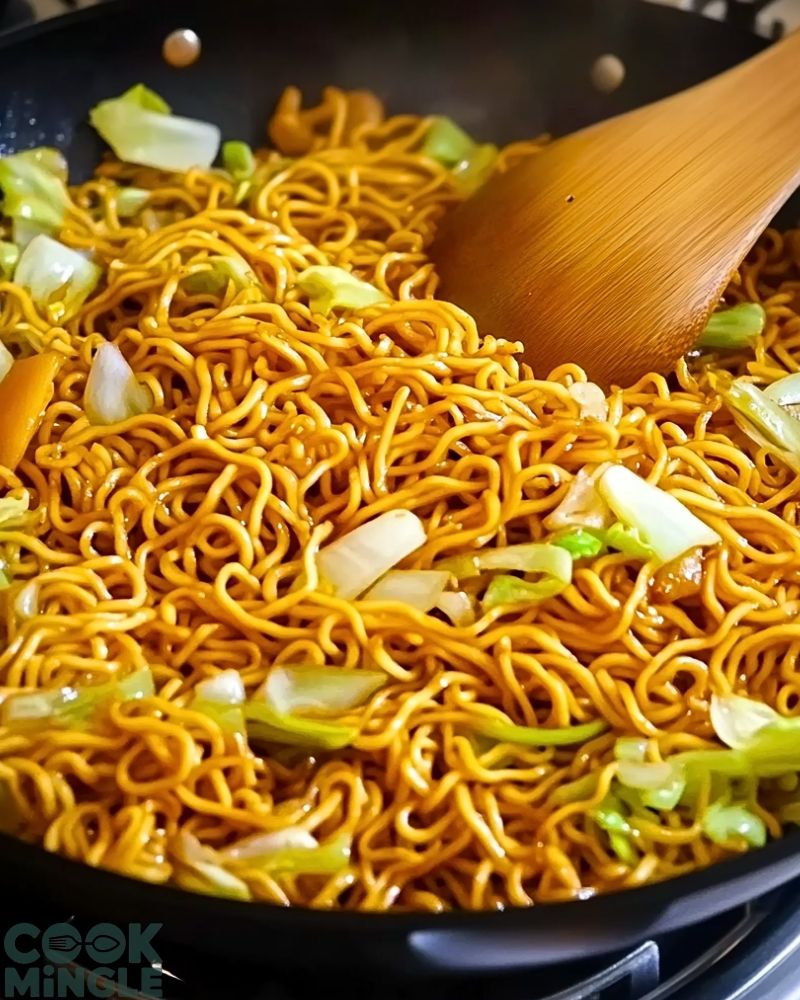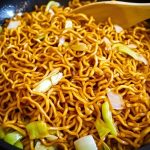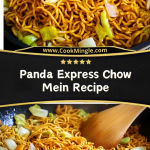I’ve always loved recreating restaurant-style dishes at home, and one of my all-time favorites to make is the Panda Express Chow Mein. It’s incredibly simple, packed with flavor, and instantly satisfying. Whether you’re in the mood for a quick lunch or want to impress someone with a comforting dinner idea, this dish nails it every time. The combination of chewy noodles, tender cabbage, and the rich soy-based sauce delivers that signature takeout taste—without needing to leave your kitchen.

The beauty of this chow mein recipe lies in its balance—savory, slightly sweet, and bursting with umami. I like how it lets the noodles shine while still giving the veggies their moment. It’s become my go-to easy recipe whenever I crave something quick yet comforting. Trust me, once you master this, it’s going to earn a permanent spot in your weekly dinner rotation.
Why You’ll Love This Panda Express Chow Mein Recipe
- Quick and easy – Ready in under 30 minutes, perfect for busy weeknights.
- Just like takeout – Tastes authentic and satisfying, but fresher.
- Budget-friendly – Uses simple pantry staples and vegetables.
- Flexible – Great base recipe to add proteins like chicken, shrimp, or tofu.
- One-pan wonder – Minimal cleanup and maximum flavor.
What Kind of Noodles Should I Use for Panda Express Chow Mein?
To get as close as possible to the signature taste and texture of Panda Express, I recommend using yakisoba noodles. They’re easy to find in the refrigerated or international aisle of most grocery stores. These noodles have that slightly chewy, springy bite that works perfectly in stir-fry dishes. If you can’t find yakisoba, dry ramen noodles (without the seasoning packet) or even thin lo mein noodles are great substitutes.
Avoid overly thin noodles like rice vermicelli or soba—they don’t hold the sauce or pan-fry well enough for that classic chow mein experience. The goal is a noodle that absorbs flavor while keeping a pleasant firmness when tossed with vegetables and sauce.
Options for Substitutions
One of the reasons I love this recipe is its flexibility. You can easily swap ingredients based on your taste or what you have in your fridge:
- Noodles: If yakisoba isn’t available, try cooked spaghetti or linguine in a pinch.
- Cabbage: Both green and Napa cabbage work. Even bagged coleslaw mix makes a great shortcut.
- Onion: Yellow, white, or sweet onion all add that needed aromatic crunch.
- Celery: Adds a nice texture, but can be replaced with bok choy, zucchini, or bell pepper.
- Soy Sauce: For gluten-free options, use tamari or coconut aminos.
- Vegetarian/Vegan: The base recipe is meat-free. For added protein, toss in tofu, tempeh, or edamame.
- Oyster Sauce (optional): Adds depth, but can be replaced with mushroom sauce for a vegan alternative.
Ingredients for This Panda Express Chow Mein Recipe
Each ingredient plays a role in building the flavor and texture that makes this dish so crave-worthy. Here’s what you’ll need and why it matters:
- Yakisoba Noodles – These wheat-based noodles are the heart of the dish, offering that chewy, springy texture iconic to chow mein.
- Green Cabbage – Adds a subtle sweetness and crunch that balances the softness of the noodles.
- Celery – Offers a fresh, slightly bitter bite and crisp texture that cuts through the richness.
- Yellow Onion – Brings a mild, aromatic sweetness once sautéed, layering flavor into every bite.
- Soy Sauce – The base of the savory sauce, it delivers umami and depth.
- Oyster Sauce – Optional, but enhances the overall richness with its slightly sweet and earthy profile.
- Garlic – Adds punchy aroma and sharp flavor, essential for stir-fried dishes.
- Vegetable Oil – Needed for stir-frying; helps evenly cook the veggies and noodles while preventing sticking.
- Sesame Oil – Just a splash at the end enhances aroma and gives the dish that classic stir-fry finish.

Step 1: Prepare the Noodles
Start by loosening the yakisoba noodles. If you’re using refrigerated ones, they might be clumped—just microwave them for 1 minute or run them under hot water, then gently separate them with your fingers or chopsticks. Drain thoroughly if rinsed.
Step 2: Slice the Vegetables
Thinly slice your cabbage, celery, and onion. Aim for uniform strips so they cook evenly. Finely mince the garlic. Prepping everything before you start cooking is key since stir-frying happens fast.
Step 3: Heat the Oil
In a large wok or deep skillet over medium-high heat, add a tablespoon of vegetable oil. Once hot, toss in the minced garlic and sauté for about 30 seconds until fragrant—don’t let it burn.
Step 4: Stir-Fry the Vegetables
Add the sliced onion, cabbage, and celery to the pan. Stir-fry for 3–4 minutes until the vegetables are tender-crisp. They should still have a bit of crunch—this contrast is what gives the chow mein texture.
Step 5: Add the Noodles
Toss in the noodles and gently fold them into the vegetables. Don’t mash them—use tongs or two utensils to mix carefully so they stay intact.
Step 6: Pour the Sauce
Drizzle in the soy sauce, a bit of oyster sauce (if using), and a dash of sesame oil. Stir everything together, letting the noodles soak up the sauce for another 2–3 minutes over medium heat.
Step 7: Taste and Adjust
Give the noodles a taste. If it needs a little more saltiness or umami, add a splash more soy sauce or a pinch of salt. Serve hot, directly from the pan.
How Long to Cook the Panda Express Chow Mein
This chow mein recipe is incredibly fast from start to finish. Once your ingredients are prepped, the actual cooking takes about 10–12 minutes:
- Vegetables: 3–4 minutes to stir-fry until tender-crisp
- Noodles and sauce: 3–5 minutes to combine and heat through
- Total cooking time: Around 8–10 minutes on the stove
- Prep time (slicing and noodle prep): About 10 minutes
This makes it ideal for a quick weeknight dinner or even a lazy weekend lunch. No long simmering, no oven—just fast and flavorful.
Tips for Perfect Panda Express Chow Mein
- Use a large wok or wide skillet – Space is essential for proper stir-frying. Overcrowding will steam your ingredients instead of browning them.
- Medium-high heat is your friend – It gives you that slight char and smoky flavor you get from takeout-style noodles.
- Prep everything first – Chop veggies, loosen noodles, and measure sauces before turning on the stove. Stir-frying goes fast.
- Don’t overcook the veggies – The goal is tender with a bit of snap, not soft and wilted.
- Toss gently – Use tongs or two spatulas to fold the noodles and sauce in carefully without breaking them apart.
- Finish with sesame oil – A small drizzle at the end enhances the overall aroma and gives that signature chow mein taste.
- Double the sauce if you like it saucy – For a bolder flavor or juicier noodles, increase the sauce ingredients slightly.
Watch Out for These Mistakes While Cooking
Even though this Panda Express Chow Mein is a simple recipe, a few small missteps can affect the final flavor or texture. Here are some things to keep an eye on:
- Overcrowding the pan – When the pan is too full, the ingredients steam instead of fry, leaving you with soggy noodles and limp vegetables.
- Not pre-cooking or loosening the noodles – Stir-frying cold, clumped noodles can lead to uneven cooking and a gummy texture.
- Skipping the high heat – Chow mein needs that quick, hot stir-fry to get the slightly charred, toasty notes. Medium heat won’t cut it.
- Adding the sauce too late – The noodles need time to absorb the sauce flavor. Don’t just drizzle and serve—let it simmer in.
- Overcooking the vegetables – You want crisp-tender cabbage and celery, not mushy stir-fry.
- Using too much oil – A little goes a long way. Too much oil will weigh down the noodles.
- Forgetting to taste and adjust – Soy sauces vary in saltiness. Always taste before serving to get the seasoning just right.
- Not using sesame oil at the end – This finishing touch makes a huge difference in replicating that Panda Express flavor.
What to Serve With Panda Express Chow Mein?
Pair your chow mein with other Asian-inspired dishes to create a full, balanced meal. Here are some ideas:
Orange Chicken
That sweet, sticky glaze over crispy chicken pairs perfectly with the savory noodles.
Vegetable Spring Rolls
Crispy, golden rolls filled with veggies add crunch and contrast.
Chicken Skewers (Teriyaki or Satay)
Grilled and glazed, these bring smoky flavor and a touch of sweetness.
Garlic Green Beans
Fresh, crunchy beans tossed in a garlicky sauce are a great veggie side.
Egg Drop Soup
A light, savory soup balances the richness of chow mein.
Spicy Korean Cucumber Salad
Adds a cool, tangy kick to cut through the noodles’ warmth.
Shrimp Tempura
Crispy and delicate, it adds protein and texture variety.
Steamed Dumplings
Whether pork, veggie, or shrimp, these juicy bites complete the takeout vibe.
Storage Instructions
Panda Express Chow Mein stores beautifully and even tastes better the next day as the flavors meld. Here’s how to keep it fresh:
- Refrigerator: Store leftovers in an airtight container for up to 4 days. Let the noodles cool fully before sealing to avoid condensation.
- Reheating: For best results, reheat in a skillet over medium heat with a splash of water or soy sauce to loosen the noodles. You can also microwave it in short bursts, stirring in between.
- Freezing: While you can freeze chow mein, the texture of the noodles and vegetables can suffer. If you must, freeze in portioned containers for up to 1 month, and thaw in the fridge before reheating.
Estimated Nutrition
Here’s a rough estimate for a 1-cup serving of this homemade chow mein:
- Calories: 260
- Protein: 6g
- Carbohydrates: 35g
- Fat: 10g
- Saturated Fat: 1.5g
- Fiber: 3g
- Sugar: 4g
- Sodium: 750mg (can vary based on soy sauce brand)
These values may fluctuate depending on the noodles and sauces you use, but overall, this dish is a reasonably balanced comfort food with plant-based ingredients and room for lean protein additions if desired.
Frequently Asked Questions
What kind of noodles are best for chow mein?
Yakisoba noodles are ideal because of their chewy texture and quick cook time. Lo mein or ramen noodles (without the seasoning) also work well.
Can I make this recipe gluten-free?
Yes! Use gluten-free soy sauce (like tamari) and make sure your noodles are gluten-free. Also skip oyster sauce or use a gluten-free version.
Can I add meat or tofu to the recipe?
Absolutely. Grilled chicken, shrimp, beef strips, or crispy tofu are all fantastic protein options to toss in during the final stir-fry step.
How do I keep the noodles from sticking?
Toss them with a little oil after loosening and before cooking. Using a nonstick pan or well-seasoned wok helps too.
Can I double the recipe?
Yes, but use a larger pan or cook in two batches to avoid overcrowding and ensure even stir-frying.
Is this recipe spicy?
Not at all. It’s flavorful but mild. If you want heat, add red pepper flakes or a drizzle of chili oil to spice it up.
Can I use pre-shredded cabbage or coleslaw mix?
Definitely. It’s a great shortcut that saves prep time without sacrificing texture.
What oil should I use for stir-frying?
A neutral oil with a high smoke point like vegetable, canola, or avocado oil works best. Sesame oil is only for finishing—not for high-heat stir-frying.
Conclusion
If you’re craving takeout-style comfort food made with fresh ingredients in under 30 minutes, this Panda Express Chow Mein recipe is your new go-to. It’s quick, simple, and delivers that authentic restaurant flavor right from your own kitchen. Whether you keep it veggie or load it with protein, this chow mein is endlessly customizable and perfect for lunch, dinner, or meal prep. Once you try it, you’ll wonder why you ever ordered out.

Panda Express Chow Mein Recipe
- Total Time: 20 minutes
- Yield: 4 servings
Description
Craving your favorite takeout noodles but want something quicker and fresher? This Panda Express Chow Mein recipe is the answer. A delicious and easy recipe that delivers chewy yakisoba noodles tossed with stir-fried cabbage, celery, and onions in a savory soy-based sauce—just like your go-to side at the famous chain. Whether you’re looking for quick dinner ideas, a budget-friendly lunch, or just want to expand your food ideas list, this chow mein hits all the right notes. The aroma of sesame oil, the crunch of fresh veggies, and the richness of the sauce come together in one comforting dish that’s better than takeout.
Ingredients
- 1 (14 oz) package yakisoba noodles (loosened and drained)
- 2 cups green cabbage, thinly sliced
- 1/2 cup celery, thinly sliced
- 1/2 cup yellow onion, thinly sliced
- 2 cloves garlic, minced
- 2 tbsp soy sauce
- 1 tbsp oyster sauce (optional)
- 1 tbsp vegetable oil
- 1 tsp sesame oil
Instructions
- Prepare the yakisoba noodles by microwaving or rinsing with hot water, then loosen and drain.
- Slice the cabbage, celery, and onion thinly. Mince the garlic.
- In a large skillet or wok over medium-high heat, heat vegetable oil. Add garlic and sauté for 30 seconds.
- Add onion, cabbage, and celery. Stir-fry for 3–4 minutes until tender-crisp.
- Toss in the noodles and gently fold them into the vegetables.
- Add soy sauce, oyster sauce (if using), and sesame oil. Stir everything together for 2–3 minutes.
- Taste and adjust seasoning if needed. Serve hot.
- Prep Time: 10 minutes
- Cook Time: 10 minutes

